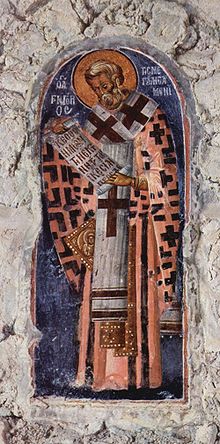Phelonion

The phelonion (Greek: φαιλόνιον, plural, φαιλόνια, phailónia; Latin: paenula) is a liturgical vestment worn by a priest of the Eastern Christian tradition. It is worn over the priest's other vestments and is equivalent to the chasuble of Western Christianity.
History[]
Like the chasuble, the phelonion was originally a sort of poncho, a conical round vestment with a hole in the middle for the head, which fell to the feet on all sides.[1] It derived from the roman civilian paenula, and it was made of wool, silk, or linen.[1] Unlike the chasuble, it was worn at all liturgical functions, not only at the Eucharist. It was in use as early as the sixth century for priests, bishops, and also minor orders, and can be seen in the mosaics in Ravenna and the Euphrasian Basilica in Porec.[1] The phelonion is depicted in the Menologion of Basil II, dating to 1000 AD.[2][1] It shape evolved, and it was folded above the elbows to free the arms and hands.
In its present form (dating from about the fifteenth century) the front is largely cut away (from about the waist down) to facilitate the movements of the priest's hands. In Russia the longer front remained common until quite recent times. The use of the phelonion is not limited to the Divine Liturgy but is specified for any major liturgical function. It is also called phenolion (φαινόλιον; plural phenolia φαινόλια) in some books.
Polystavrion[]
Originally the bishops wore a phelonion identical to that worn by priests and it could be of any solid color. Starting in the 11th century, a special phelonion, called the polystavrion o polystaurion ("many crosses") phelonion developed for certain prelates, and it was made of cloth that was either woven or embroidered with a pattern of multiple crosses.[1] The twelfth century canonist Theodore Balsamon deemed it strictly reserved for the patriarch. No polystavrion has survived from the Byzantine period, and it was gradually supplanted by the sakkos.[1]
Styles[]
There are two main styles of phelonion. Byzantine- or Greek-style phelonia are tailored to fit over the shoulders, while Russian-style phelonia (Фелонь, felon) have a high, stiffened collar that covers the back of the head. There is also a shortened phelonion (Фелончик, felonchik) that is worn by a reader at his tonsuring. This small phelonion is still worn by altar servers in Old Believers churches. The Greek-style phelonion is, generally speaking, worn by those with a historical and geographical closer tie with the Patriarch of Constantinople, which would include most Eastern Orthodox Christians in the Middle East, Greece, the Balkans, Romania, Bulgaria, as well as Greek-Catholics and Orthodox in western Ukraine.

The Russian-style phelonion is used by the Russian Orthodox, Ukrainian Autocephalous, Ukrainian Orthodox (Moscow Patriarchate), Polish Orthodox churches, as well as the Orthodox Church in America. There is also a version used by some Ukrainian and Bulgarian Orthodox which is half-way between the Russian and Greek styles.


A bishop who wishes to serve a Divine Liturgy as a priest (i.e., without the special rites and prayers of the Hierarchical Divine Liturgy) will sometimes vest in a phelonion instead of his sakkos, but with the omophorion around his neck. This is also done in the Liturgy of St. James.
In Oriental Orthodoxy, the phelonion is often only clasped at the neck, and is thus more open than the Byzantine-style, resembling a Western cope. Its various names are phanolion (Coptic), paynā (Assyrian), phayno (Syriac Orthodox), šurdzar (Armenian) and kāppā (Ethiopian). These are worn by bishops as well as priests (the sakkos is not worn by priests).
External links[]
 Media related to Phelonion at Wikimedia Commons
Media related to Phelonion at Wikimedia Commons
Sources[]
Woodfin, Warren T. (2012). The embodied icon : liturgical vestments and sacramental power in Byzantium. Oxford [Great Britain]: Oxford University Press.
References[]
- ^ Jump up to: a b c d e f Woodfin, Warren T. (2012). The embodied icon : liturgical vestments and sacramental power in Byzantium. Oxford [Great Britain]: Oxford University Press. ISBN 978-0-19-959209-8. OCLC 714724958.
- ^ Moran, Neil K. (1986). Singers in Late Byzantine and Slavonic Painting. BRILL. ISBN 978-90-04-07809-3.
- Eastern Christian vestments
- History of clothing
- History of clothing (Western fashion)
- History of fashion
- Byzantine clothing